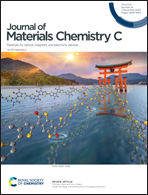Enhanced hydrolytic and electrical stability of eco-friendly processed polyimide gate dielectrics for organic transistors†
Abstract
Here, eco-friendly, low-temperature solution-processed polyimide (PI) thin films with high hydrolytic stability under ambient air have been successfully developed for gate dielectric layers in organic field-effect transistors (OFETs). Poly(amic acid) (PAA), a precursor of PI based on 3,3′,4,4′-biphenyltetracarboxylic dianhydride (BPDA) and p-phenylenediamine (pPDA) with 1,2-dimethylimidazole, is synthesized through a one-step polymerization reaction in deionized water as a solvent. The incorporation of 1,2-dimethylimidazole allows the formation of the ammonium salt of PAA (PAAS), which exhibits a significant enhancement in hydrolytic stability and solubility in deionized water. The chemical structure and material properties of PAAS polymerized in deionized water (W-PAAS) are investigated to determine the effect of the solvent on the polymerization compared to those of PAA polymerized in organic solvent (O-PAA). The hydrolytic stability of O-PAA and W-PAAS is explored by identifying the surface morphology of O-PI and W-PI thin films prepared in inert, ambient, and humid air. W-PI thin films provide more reliable surface properties and superior electrical performances compared to O-PI thin films. In particular, owing to the excellent hydrolytic stability of W-PAAS, OFETs with W-PI gate dielectrics have a yield of 100% at low temperature below 250 °C, regardless of the processing environment.



 Please wait while we load your content...
Please wait while we load your content...